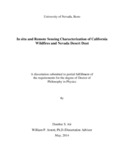Please use this identifier to cite or link to this item:
http://archive.nnl.gov.np:8080/handle/123456789/255| Title: | In situ and remote sensing characterization of California wildfires and Nevada desert dust |
| Authors: | Air, Dambar S. |
| Keywords: | California Rim fire Dusr storm - Reno |
| Issue Date: | 5-Dec-2017 |
| Abstract: | Atmospheric aerosols exert significant influence on the climate and cause problems in human health and ecosystem. This dissertation reports aerosol physical and optical properties obtained from ground based remote sensing instruments, the Multifilter Rotating Shadowband Radiometer (MFRSR) and Cimel sun photometer, and in-situ measurements from photoacoustic (PA) instruments. The measurements were performed during California Rim fire of 2013, desert storm of 2013, and clear sky days. A 2-stream radiation transfer model and Mie theory were used to calculate the retrieved values of solar irradiances and aerosol optical properties. The ground based measurements were also compared with the satellite (Terra MODIS, Aqua MODIS and Deep Blue) measurements. The aerosol optical properties retrieved with the MFRSR show excellent agreement with those obtained with a co-located Cimel sun photometer. However, the comparison with the satellite measurements indicates significant departure from the ground based measurements. The values of the aerosol optical depth (AOD) and Ångström exponent (AE) during the Rim fire event remained higher than clear sky days due to the presence of smoke particles in the atmosphere. However, the values of AOD during the dust storm were higher but the AE become lower than the clear sky days due to the presence of large particles in the atmosphere. The concentration of the fine mode (diameter less than 1 ) dominates over the coarse mode (diameter greater than 1 ) particles during the Rim fire, while coarse particles were more prevalent during dust storm. Back trajectory analysis during the Rim fire indicated that the southerly wind brought the plumes of smoke which originated at California Rim fire toward Reno. Similarly, the back trajectory analysis during the dust storm suggested that the dust was generated from the Humboldt sink and traveled towards Reno. The single scattering albedo (SSA) was found to decrease with wavelength due to the absorption of solar radiation by the small black carbon particles present in the wild fire smoke. However, the SSA during the dust storm increases with wavelengths, which is due to significantly lower absorption of the dust aerosols at longer wavelengths (675-1020 nm) compared to biomass burning aerosols. It was interesting to note that the SSA values from in situ photoacoustic measurements and from the MFRSR retrievals were of very similar values during the Rim fire, suggesting that the smoke was well mixed in the atmospheric boundary layer. These novel measurements are reported here for the first time. It was found that the radiative forcing at the top of the atmosphere (TOA) varied between 38 ⁄ to 65 ⁄ from MFRSR and Cimel during the Rim fire, suggesting a massive cooling effect due to scattering of solar radiation by the high aerosol loading. By comparison, the radiative forcing at the TOA ranged between 0.5 ⁄ to 1.8 ⁄ during clear-sky days. |
| Description: | A dissertation submitted in partial fulfillment of the requirements for the degree of Doctor of Philosophy in Physics, University of Nevada, Reno, 2014. |
| URI: | http://103.69.125.248:8080/xmlui/handle/123456789/255 |
| Appears in Collections: | 500 Natural sciences and mathematics |
Files in This Item:
| File | Description | Size | Format | |
|---|---|---|---|---|
| Dambar Singh Air, PhD Thesis.pdf | 6.09 MB | Adobe PDF |  View/Open |
Items in DSpace are protected by copyright, with all rights reserved, unless otherwise indicated.